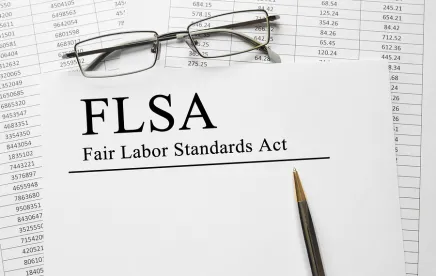Although the Fair Labor Standards Act (FLSA) includes an overtime exception for employees who reside on the work premises for an “extended” period of time – at least 120 hours in a “workweek” – that exception is inapplicable if an employer’s payroll workweek does not coincide with an employee’s scheduled workweek for at least that many hours. Giguere v. Port Resources, Inc., 2019 U.S. App. LEXIS 18391 (1st Cir. June 19, 2019).
Generally under the FLSA, an employer must pay for all time that it requires an employee to spend at a worksite, including sleep time. 29 C.F.R. § 785.7. However, U.S. Department of Labor (DOL) regulations provide that an employer may exclude sleep time if certain conditions are met. One such exception applies to “live-in” employees, defined as those who “reside[] on [the] employer’s premises on a permanent basis or for extended periods of time.” 29 C.F.R. § 785.23. In a 1988 enforcement memorandum, the DOL defined “extended periods of time” as “resid[ing] on the premises for a period of at least 120 hours in a workweek.” Further, the memorandum defined “workweek” as “seven consecutive 24-hour periods.” The memorandum added that the employer’s workweek “need not coincide with the calendar week,” but once the employer has established the day its workweek begins, the following seven-day period “remains fixed regardless of the schedule of hours worked by [the employee].” 29 C.F.R. § 778.105.
In Giguere, the employer ran group homes for adults with developmental disabilities and its employees included “long-term” staff, who worked shifts of seven days on, followed by seven days off. Each week-long shift included four 4-hour unpaid breaks and eight hours of nightly unpaid sleep time. Consistent with the language of Section 785.23, the employer implemented a “Sleep Time Agreement,” which governed the conditions of the sleep-time exception to the paid work time of the long-term staff.
However, the employer computed its payroll workweek from Sunday to Sunday, while the shift schedule for the long-term staff ran from Thursday to Thursday. Thus, each long-term shift spanned two payroll workweeks and, after subtracting the unpaid break hours and eight hours of unpaid sleep each night, the employer paid its long-term staff for 40 paid working hours during the first payroll workweek (Thursday to Saturday) and for 56 paid working hours during the second payroll workweek (Sunday to Wednesday). Believing this pay structure to unlawfully deny him all overtime due, a former long-term staffer filed a collective/class action suit, alleging violations of the FLSA and comparable Maine state law. The district court agreed with the employee, granting him and the class summary judgment on the FLSA claims, and the First Circuit Court of Appeals affirmed.
The employer’s sleep-time policy failed to comply with the FLSA because its payroll workweek did not sufficiently overlap with the shift schedule of the long-term employees to whom the sleep-time policy applied. As a result, the long-term staff did not reside on the premises for at least 120 hours during the employer-established workweek. Instead, at most these employees resided for 96 hours on-site in a given payroll workweek (56 paid hours plus 32 unpaid sleep-time hours and 8 unpaid break hours during the four-day period from Sunday to Wednesday).
While acknowledging that the DOL regulations could benefit from some clarification, the First Circuit nonetheless concluded that, lacking anything suggesting a repudiation of the Department’s 1988 memorandum opinion, and in light of the clear-cut language of the definition of “workweek” in the DOL regulations, the plaintiff “has the better reading” of the applicable law. Curiously, in support of its decision, the Court of Appeals cited to the “narrow construction” principle previously applicable to the analysis of overtime exemptions under the FLSA. Last year, that principle was uniformly rejected by the U.S. Supreme Court in Encino Motorcars, LLC v. Navarro, 136 S. Ct. 2117 (2018), in favor of a “fair reading” approach to such exemptions.
As Giguere illustrates, employers need to ensure that when considering the application of an exception to the FLSA’s general rules, all of the conditions necessary for that exception are met.




 />i
/>i